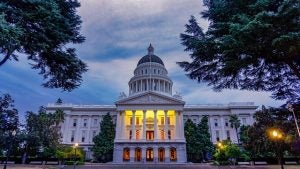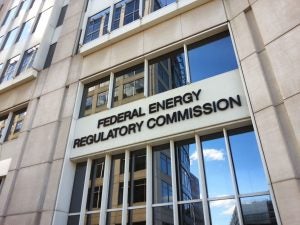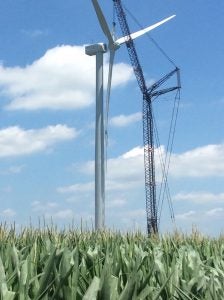 Regulators from across the country met in Vermont this week at the Environmental Council of the State’s (ECOS) fall meeting to discuss some of the nation’s most pressing environmental challenges. I joined members of ECOS’ Shale Gas Caucus to discuss an emerging threat imminently impacting oil and gas-producing states: the question of what to do with the massive amount of wastewater produced by the oil and gas industry each year.
Regulators from across the country met in Vermont this week at the Environmental Council of the State’s (ECOS) fall meeting to discuss some of the nation’s most pressing environmental challenges. I joined members of ECOS’ Shale Gas Caucus to discuss an emerging threat imminently impacting oil and gas-producing states: the question of what to do with the massive amount of wastewater produced by the oil and gas industry each year.
Monthly Archives: August 2018
State leaders concerned about safety of reusing oil and gas wastewater
Moment of truth arrives for California legislators as clean energy bills clear final amendment hurdles
By Tim O’Connor and Lauren Navarro
The California legislative session closes this Friday, and two important pieces of clean energy and climate legislation (AB 813 and SB 100) hang in the balance.
 After months of negotiations and amendments, AB 813 is in the California Senate and is ready for Senate President pro Temp Toni Atkins to assign it to a vote. SB 100 has already passed the Senate and is being considered in the Assembly. Lawmakers should pass both and supercharge the region’s clean energy efforts.
After months of negotiations and amendments, AB 813 is in the California Senate and is ready for Senate President pro Temp Toni Atkins to assign it to a vote. SB 100 has already passed the Senate and is being considered in the Assembly. Lawmakers should pass both and supercharge the region’s clean energy efforts.
One of the biggest reliability and air quality initiatives in the West, AB 813 would create a regional electric grid and empower Western states to buy and sell more clean energy with each other. That would be good for clean energy efforts in each state, but it would be particularly helpful in California, where we could export our excess clean energy instead of wasting (or curtailing) it. As a result, the region would rely less on local fossil fuel plants to power homes and businesses.
How New Jersey can finance its bold new clean energy targets
By Dakota Gangi and Mary Barber
 On May 23, New Jerseyans scored a major economic and environmental victory when Governor Phil Murphy signed a groundbreaking law that will soon make the Garden State an even greener one. The Board of Public Utilities (BPU) has initiated a proceeding that will establish a community solar pilot program within one year of the bill’s signing. Low-income and multifamily households will be able to earn credits on their electric bills for purchasing power from a shared solar array. In just ten years, half the state’s power will come from emissions-free renewable resources, and New Jersey will boast the highest amounts of energy storage and offshore wind in the United States. New Jerseyans can expect clean air, electric bill savings, and the creation of many local and lucrative job openings.
On May 23, New Jerseyans scored a major economic and environmental victory when Governor Phil Murphy signed a groundbreaking law that will soon make the Garden State an even greener one. The Board of Public Utilities (BPU) has initiated a proceeding that will establish a community solar pilot program within one year of the bill’s signing. Low-income and multifamily households will be able to earn credits on their electric bills for purchasing power from a shared solar array. In just ten years, half the state’s power will come from emissions-free renewable resources, and New Jersey will boast the highest amounts of energy storage and offshore wind in the United States. New Jerseyans can expect clean air, electric bill savings, and the creation of many local and lucrative job openings.
These groundbreaking targets can bring about significant economic growth, especially if New Jersey utilizes a multitude of green financing tools to achieve its goals. The BPU will ensure the state is on track to meet its clean energy goals, as it is putting in place rules and regulations to attract investment. Now, New Jersey should create a green bank to add to its arsenal of green investment mechanisms and to fill the clean energy financing gap identified in EDF’s December 2017 report, Financing New Jersey’s Clean Energy Economy: Pathways for Leadership.
Cowboy up: Wyoming’s new oil and gas proposal helps state lead on air quality
 Wyoming is not a state that likes to take a backseat to anybody, especially when it comes to setting energy policy. That’s why it’s no surprise the state recently proposed new standards to reduce harmful, wasteful emissions from the state’s oil and gas facilities.
Wyoming is not a state that likes to take a backseat to anybody, especially when it comes to setting energy policy. That’s why it’s no surprise the state recently proposed new standards to reduce harmful, wasteful emissions from the state’s oil and gas facilities.
The requirements in the state’s new proposal are an extension of a successful emission-reduction program implemented in 2015 to improve air quality in western Wyoming, where unchecked oil and gas development led to unhealthy pollution levels.
FERC approves pipeline despite concern over controversial business arrangement
 Last week, the Federal Energy Regulatory Commission (FERC) approved the proposed Spire STL Pipeline. Blessings for the controversial 66-mile project come even though St. Louis already enjoys excess capacity from other pipelines, and despite the fact that the only customer of the pipeline, Spire Missouri, does not actually have any growth in customer demand. It is estimated that the project will cost ratepayers $30 million annually over the next twenty years.
Last week, the Federal Energy Regulatory Commission (FERC) approved the proposed Spire STL Pipeline. Blessings for the controversial 66-mile project come even though St. Louis already enjoys excess capacity from other pipelines, and despite the fact that the only customer of the pipeline, Spire Missouri, does not actually have any growth in customer demand. It is estimated that the project will cost ratepayers $30 million annually over the next twenty years.
The proceeding reveals much about how the agency assesses the legally-required “market need” for new pipelines when both buyer and seller in the contract used to demonstrate that market need are two different arms of the same company. These so-called affiliate transactions are a growing trend as retail gas utilities seek new revenue to offset stagnating demand.
The risk with these types of transactions is that we could end up with expensive new pipelines that aren’t needed. What’s more, these deals are specifically engineered to shift financial responsibility for these costly projects away from private shareholders and onto retail ratepayers (i.e., the public). They can also lock utility customers into decades-long gas contracts at precisely the time when competitive alternatives – from renewables to energy storage – are transforming the market. Spire presents a textbook example of these concerns.
North Carolina celebrates ‘American Wind Week’ with optimism for the future
 Governor Roy Cooper has issued a proclamation recognizing August 5-11 as “American Wind Week” here in North Carolina. It’s a good time to reflect on our clean energy progress – as a nation and as a state – and to consider what’s next.
Governor Roy Cooper has issued a proclamation recognizing August 5-11 as “American Wind Week” here in North Carolina. It’s a good time to reflect on our clean energy progress – as a nation and as a state – and to consider what’s next.
The amount of energy generated from wind turbines has more than tripled in the United States in the last decade, according to the American Wind Energy Association (AWEA), representing 6.3 percent of the nation’s generation mix last year. The Tar Heel state can take credit for a tiny portion of that with the 104 turbines generating power at the Amazon East Wind Farm near Elizabeth City, but we are lagging behind with wind representing only 0.4 percent of our state’s energy mix. Read More









